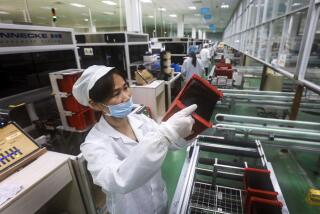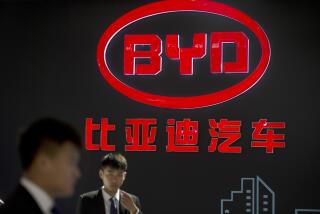Cars to Be Part of U.S.-Japan Trade Talks Again : Commerce: Autos and auto parts account for three-fourths of the import-export imbalance between the two nations.
TOKYO — Six years after taking automobiles off the agenda in U.S.-Japan trade negotiations, Washington has put the topic back on. And, according to J. Michael Farren, U.S. undersecretary of commerce, it has been restored to the front burner.
In two days of negotiations with Japanese officials last week, the United States won agreement from the Ministry of International Trade and Industry (MITI) to include trade in finished automobiles as a new subject in ongoing negotiations that until now had focused only on auto parts, Farren told reporters Friday.
Although U.S.-Japan automobile trade has consistently accounted for half or more of the American trade deficit with Japan, the new move marks the first official attention Washington has paid to the issue since then-President Ronald Reagan informed Japan in 1985 that the United States no longer wanted voluntary export quotas on passenger cars.
American officials are concerned that the U.S. trade deficit in autos with the Japanese will continue to grow and that U.S. auto makers are not making sufficient inroads into the Japanese car market.
MITI’s agreement to include trade in finished automobiles in the negotiations on auto parts came after President Bush mentioned the issue to Prime Minister Toshiki Kaifu during a meeting in Bush’s summer home in Kennebunkport, Me., on July 12.
The off-and-on approach to passenger car trade--despite a $19.5-billion deficit in that category last year--underscores the criticisms of U.S. negotiating techniques with Japan. These barbs have come from such authorities as Clyde V. Prestowitz Jr., who served in the Commerce Department during the Reagan years. Prestowitz has charged that Washington lacks consistency in pressing its case with Japan.
On Friday, Farren attempted to defend Washington’s neglect of the auto trade issue by saying that both Commerce Secretary Robert A. Mosbacher and Vice President Dan Quayle had mentioned it earlier. But he acknowledged that the new agreement with MITI marks “the first time that we’ve raised it to this level.”
Farren expressed alarm over the extent to which the U.S. auto industry is being backed into a corner. If cars leased by customers such as auto rental agencies are excluded, Detroit’s Big Three held only 49% of the share of the U.S. market for passenger cars in 1990, he said. Cars made in Japan and in the United States by Japanese manufacturers accounted for 42% of the nonlease passenger car market, he added. Imports held a 26.3% share of the overall market, with shipments from Japan accounting for 18.4%, Farren said.
In value, Japan’s exports of both finished automobiles, including trucks and vans, and parts amounted to $32.1 billion last year, Commerce Department statistics showed.
Noting that a University of Michigan study recently warned that the auto trade deficit with Japan, by itself, could reach $46 billion by 1994, Farren said half the 1990 overall bilateral deficit of $41 billion came from trade in finished automobiles and another quarter from trade in auto parts. “It will be very difficult to bring into balance U.S.-Japan trade without dealing with the current--and growing--imbalance in automotive trade,” he said.
He insisted, however, that the Bush Administration “is not interested in any solution that involves restrictions” on Japanese exports--despite the fact that the task of expanding U.S. exports faces a monumental uphill struggle. Last year, Japan exported 1.7 million cars to the United States, while the Big Three sold a mere 13,338 in Japan.
The two governments, he said, will carry out a “joint study of market conditions” affecting sales of automobiles in Japan, then decide what steps to take at a high-level meeting in late January or early February.
He said the Commerce Department does not yet “have a timetable or a measure” by which to gauge success in any effort to increase sales in Japan of U.S.-made cars and confessed that “we don’t have a clear vision of the big picture now.”
Farren said not only impediments to sales in Japan but also practices of Detroit’s Big Three will be scrutinized. The Big Three, he said, “will need to be prepared to respond to questions . . . that may be difficult.”
The Commerce Department official also announced the results of a survey conducted by A. T. Kearney, a consulting firm based in Japan, that painted a dim picture of U.S. auto parts sales to Japan. The survey concluded that Japanese parts manufacturers have strengthened their grasp on sales, making it even harder for third-party manufacturers, like U.S. firms, to sell to car owners, he said.
Japanese car makers and companies under contract to them hold about 90% of the after-market in parts and accessories, Farren said. As a result, U.S. parts makers--which generally lack relationships with Japanese auto makers--find entry into the market “very limited and . . . getting worse,” he said.
More to Read
Inside the business of entertainment
The Wide Shot brings you news, analysis and insights on everything from streaming wars to production — and what it all means for the future.
You may occasionally receive promotional content from the Los Angeles Times.










